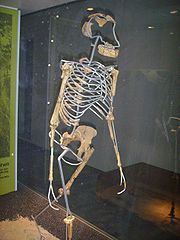Ancestors of humans learned to walk in trees, study says

Sunday, June 3, 2007
Scientists from the United Kingdom who spent one year watching orangutans have revealed in a study that humans may have learned to walk while still living in the trees, and that humans may not be that closely related to chimpanzees.
"An increasing number of people have been questioning this old 'up from the apes' idea" of how bipedalism evolved. As the forests became sparse, the strategy of our human ancestors was more or less to abandon the canopies and come down to the ground, where they could use this bipedalism immediately to get around," said one University of Liverpool scientist who headed the study, Robin Crompton.
Museums and schools across the world have been teaching that humans evolved from an animal much like that of a chimpanzee and that humans started to walk along the forest floors, with their arms hanging, and knuckles scraping across the ground. It is also taught that those animals then began to walk upright once they adapted to living on the ground.
Orangutans were observed by researcher Susannah Thorpe of the University of Birmingham in Sumatra, Indonesia for one year. She documented that the orangutans would generally walk on their hands and feet, but when food was at a height that they could not reach, the orangutans would stand on their feet, extend upright, and grab the fruit or food item they want. This movement also allowed them to swing from the branches of trees more efficiently, without having to touch the forest floor.

Image: Gerbil.
"When they move to the skinniest branches, where the tastiest fruit grows, they stand stiffly straight-legged, like a person. It's energetically quite economical for orangutans to feed and move on these bendy branches using bipedalism," said Thorpe who also has over 3,000 different movements on film that show orangutans standing on their own 2 feet, upright, and reaching for objects.
"Our conclusion is that arboreal bipedalism had very strong adaptive benefits. So, we don't need to explain how our ancestors could have gone from being quadrupedal to being bipedal," added Thorpe.
The researchers also compared evidence from the remains of Lucy, past climate conditions on the planet and fossils to the workings of orangutans, and all suggest that humans were living and swinging in the trees for a much longer period of time than previously thought. The study shows that humans may have learned to walk at least 24 million years ago, rather than 6 million years ago.
Some experts disagree with the study.
"The main evidence is that our closest living relatives are not orangutans, they're chimps and gorillas, and since both climb trees and walk on their knuckles, it's most likely our ancestors did that too. One of the only anatomical features we share explicitly with chimps and gorillas is that we only have eight wrists bones, while almost all other primates have nine. In humans, chimps and gorillas, two bones have fused into one to stabilise the wrist, making it stronger for knuckle-walking. It's not a smoking gun, but it's the best evidence we have," said anthropologist at George Washington University, Brian Richmond.
Sources
- Ian Sample. "New theory rejects popular view of man's evolution" — Hindu, June 2, 2007
- "Press Release: Lessons From The Orangutans: Upright Walking May Have Begun In The Trees" — Science Daily, June 1, 2007
- Associated Press. "Study: Humans May Have Learned to Walk Upright in Trees" — FOX News, June 1, 2007
